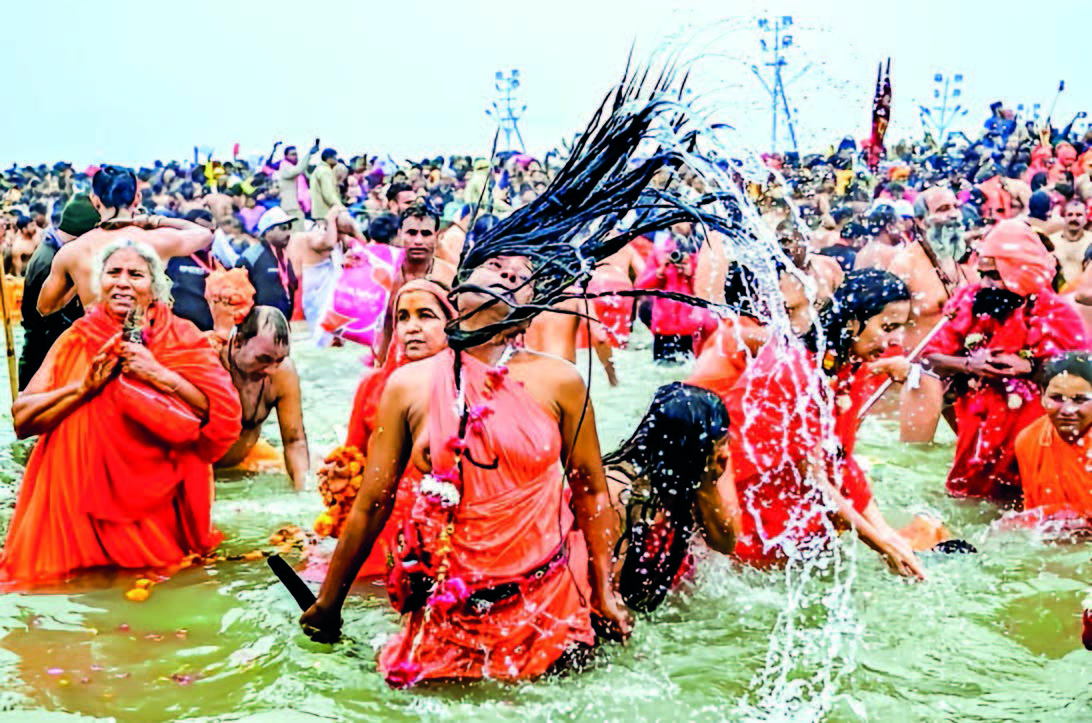PRIME Minister Narendra Modi has consistently underscored the importance of the Kumbh Festival on international platforms, inviting the Indian diaspora and global admirers of Indian culture to witness this unparalleled spiritual event. But what makes the Kumbh Festival not only a symbol of Indian tradition but also a global phenomenon?
Historical and Mythological Roots
The Kumbh Festival is one of humanity’s oldest and most sacred gatherings, deeply embedded in Vedic mythology. Its origins trace back to the legend of Samudra Manthan (churning of the ocean), where the gods and demons competed for the nectar of immortality. Drops of amrit (nectar) fell at four locations — Haridwar, Prayagraj, Ujjain, and Nashik — sanctifying these places and establishing them as the venues for the Kumbh Festival.
Ancient scriptures such as the Skanda Purana and the Vayu Purana extol the spiritual benefits of participating in the Kumbh. They emphasize that rituals and holy dips during this festival lead to salvation, marking it as a key spiritual practice in Sanatan Dharma.
Astronomical Alignments and Timing
The Kumbh Festival is uniquely governed by celestial alignments of the Sun, Moon, and Jupiter in specific zodiac signs, as described in the scriptures. It is held every six years (Ardh Kumbh) and every twelve years (Purna Kumbh) at the following locations based on these alignments:
Haridwar: Sun in Aries, Jupiter in Aquarius.
Prayagraj: Sun in Capricorn, Jupiter in Taurus.
Ujjain: Sun and Jupiter both in Leo.
Nashik: Similar configurations.
This precise timing adds to the festival’s spiritual significance, with devotees believing that bathing in the sacred rivers during these auspicious periods cleanses sins and brings spiritual merit.
Kumbh: A Platform for Global Outreach
The Kumbh Festival’s inclusion in UNESCO’s Intangible Cultural Heritage of Humanity is a testament to its universal appeal. By showcasing India’s spiritual ethos, it has become an essential part of India’s soft power diplomacy.
1. Tourism and Economic Growth
The Kumbh attracts millions of pilgrims and global visitors, contributing significantly to spiritual tourism. Events organized during Kumbh inspire exploration of Indian heritage, generating avenues for cultural exchange and economic development.
2. Diplomatic Engagements
International dignitaries, diplomats, and scholars are often invited, creating opportunities for dialogue and cultural understanding. Such initiatives foster mutual respect and enhance India’s relationships worldwide, including its historical ties with Myanmar.
3. Promotion of Indian Values
Through live broadcasts, documentaries, and social media, Kumbh highlights India’s message of universal peace and sustainability, resonating with global audiences.
Strengthening India-Myanmar Relations Through Kumbh
The bond between India and Myanmar, rooted in shared spiritual and cultural values, finds deeper resonance through festivals like Kumbh. Myanmar’s reverence for Indic traditions — reflected in Buddhism, Sanskrit, and Pali studies —makes it a key participant in cultural exchanges inspired by Kumbh.
• Cultural Exchange Programs: Encouraging participation from Myanmar in events like the Kumbh can enrich mutual understanding of heritage and traditions.
• Tourism Promotion: Introducing Kumbh-inspired packages can attract spiritual seekers from Myanmar, benefiting both nations economically and culturally.
• Artistic Collaborations: Joint exhibitions and performances highlighting shared values of peace and spirituality can strengthen ties.
A Celebration of Universal Values
The Kumbh transcends religious boundaries to emphasize universal values of harmony, sustainability, and community welfare. As global challenges demand solutions rooted in compassion and unity, the festival becomes a platform for leaders, thinkers, and seekers to converge and discuss these principles.
The Kumbh Festival transcends religious boundaries, symbolizing faith, harmony, and the eternal principles of Sanatan Dharma. It brings together millions of pilgrims, spiritual leaders, and saints who unite for rituals, discourses, and discussions on global welfare.
Prayagraj, referred to as Tirthraj (King of Pilgrimages), holds particular significance due to the confluence of the Ganga, Yamuna, and the mythical Saraswati rivers. Celebrated in the Ramcharitmanas by Goswami Tulsidas, this sacred site embodies spiritual bliss and enlightenment.
Global Recognition of Kumbh
The Kumbh Festival’s global stature was solidified when it was inscribed on UNESCO’s Representative List of the Intangible Cultural Heritage of Humanity. This recognition highlights its significance in promoting India’s cultural and spiritual values worldwide.
Prominent global spiritual leaders have played a pivotal role in spreadingSanatan Dharma:
• James Mallinson (UK): Recognized for his contributions to yoga and Sanatan philosophy.
• Swami Vishwananda (Germany): Established over 50 Vaishnav temples in Europe.
• Swami Madhavananda: Instrumental in introducing Sanatan culture to Eastern Europe.
Visionaries like Swami Vivekananda, Swami Sivananda, and Bhaktivedanta Prabhupada have further expanded India’s spiritual footprint globally, inspiring millions through their teachings on yoga, Vedanta, and bhakti.
Tourism and Cultural Exchange
The Kumbh Festival is a major driver of tourism, attracting millions of visitors from across the world. The Uttar Pradesh Tourism Department reports that the Mahakumbh in Prayagraj significantly enhances India’s global cultural appeal.
Beyond tourism, the festival serves as a platform for promoting sustainable living, environmental conservation, and human values. Spiritual leaders and scholars discuss topics of global welfare, emphasizing harmony and coexistence. The guiding mantra, “Krinvanto Vishwam Aryam” (Let us make the world noble), resonates strongly at this gathering.
Challenges and Opportunities
Despite its growing international appeal, the promotion of Sanatan culture faces challenges, such as misconceptions and limited awareness in certain regions. However, increasing acceptance of Hindu temples and traditions, even in places like the UAE and Saudi Arabia, marks a significant step toward broader recognition of Sanatan values.
The Kumbh Festival is more than a religious event; it is a living embodiment of India’s spiritual depth and cultural richness. It serves as a beacon of unity, faith, and enlightenment, inspiring humanity to embrace the timeless principles of Sanatan Dharma. Through the Kumbh, India continues to project its cultural and spiritual heritage onto the global stage, fostering harmony and mutual respect.
The festival’s enduring legacy ensures that it will remain a cornerstone of India’s cultural diplomacy and a source of global inspiration for generations to come.


